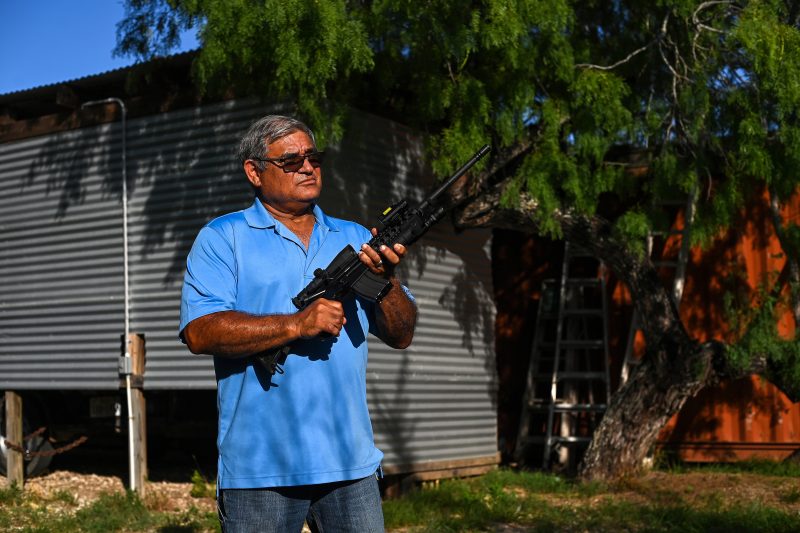
America’s toxic mix of guns, concern over crime — and fear-mongering
Last Thursday, 16-year-old Ralph Yarl went to pick up his siblings at a house in Kansas City, Mo. But Yarl went to the wrong house. Andrew Lester, 84, allegedly shot Yarl twice after the teen appeared on the doorstep; he told police he was “scared to death” by the unexpected visitor. Luckily, Yarl survived.
Kaylin Gillis, 20, didn’t. She was in a car with three other people that pulled into a driveway in rural Upstate New York on Saturday night. Realizing they were at the wrong house, the driver began to turn the car around. It was unable to pull away before Kevin Monahan, 65, allegedly fired two shots. One struck Gillis.
Both Lester and Monahan now face criminal charges, but the damage is done. In each case, the residents responded to unexpected visitors with gunfire. It is in retrospect perhaps an inevitable development, given America’s long-standing interest in firearms and our more recent obsession with elevating stories about violent crime.
It is not a secret that Americans own more guns than the residents of any other country on Earth. Civilians in the United States own 120 guns for every 100 residents, nearly twice the rate in the territory with the next-highest level of gun ownership, the Falkland Islands.
But gun ownership has surged in recent years. It’s estimated that between the mid-1990s and 2009, the number of privately owned guns in the United States went from 192 million to 310 million. And gun sales have continued to climb, with federal data on background checks showing a fairly consistent upward trend.
Importantly, gun sales have also surged in recent years during moments of perceived danger. At the outset of the pandemic in 2020 and during the racial justice protests later that year, background-check requests surged, indicating a rise in sales. The same thing happened after the riot at the Capitol in January 2021.
Gallup has measured an apparently related phenomenon. In 2000 and 2005, about two-thirds of American gun owners said they owned firearms for protection against crime, compared with 6 in 10 who said they owned guns for hunting. By 2021, the percentage who said they owned guns for hunting fell slightly — but the percentage who said they owned guns for protection against crime surged to nearly 9 in 10.
At the same time, concern about crime was rising. Gallup’s polling indicates that 50 percent of Americans expressed a “great deal” of concern about crime and violence in 2021, the highest percentage since 2016. Over the two subsequent years, that percentage has increased.
Now, 54 percent of Americans express “great concern” about crime and violence.
Crime is up relative to the pre-pandemic era, according to the best (often patchy) data, but down relative to 2020 and 2021. Relative to the 1990s, of course, crime is down substantially.
But that’s not always the message that’s conveyed in the media. For example, Fox News’s mentions of “crime” on its broadcasts have surged in recent years — particularly since President Biden was inaugurated.
As The Washington Post has reported, the increase in discussion of crime on Fox News has not been correlated to actual data about crime. But the network is nonetheless feeding off of and feeding a narrative about surging rates of crime, usually as a way of casting aspersions on urban areas run by Democrats. Fox News’s coverage since mid-2020 has disproportionately involved clips of isolated criminal activity to generate a sense of unconstrained violence in urban areas — despite evidence that the increase in crime since the pandemic also occurred in rural areas.
What Americans are most likely to consume Fox News? Older, Whiter and more conservative Americans. More conservative, of course, also means “more likely to own a gun.”
It is not only Fox News that contributes to this sense of embattlement, of course. Fox’s deployment of viral videos of criminal behavior is simply mirroring similar engagement from social media.
One such tool is Nextdoor, an app that is centered on allowing neighbors to share local information and recommendations. In practice, though, the app is often a conduit for alarmist rumor-mongering about suspicious-seeming characters. This is so much the case that the app has a page offering recommendations aimed at tamping down often stereotype-ridden posts that are common on the platform. The page includes a reminder about racial shorthand that is banned on the platform.
It gives an example:
“If you saw this post, you’d know who to look for,” the page reads. “However, there is no information that supports the allegation of suspicious behavior.”
Most Nextdoor users, it’s safe to assume, have not internalized these recommendations. Posts like the one above are common on the site. Nextdoor users are also heavily older and White.
The point is not that the shooters in Kansas City or Hebron, N.Y., were necessarily consumers of Fox News or users of Nextdoor. The odds are that they weren’t. Instead, the point is that several American trends appear to have intersected unhappily in those places over the past week: a society in which gun ownership is common, in which guns are seen as necessary tools for self-defense against crime, and in which crime is depicted, often cynically, as surging.
Perhaps Lester and Monahan will turn out to be poor representatives of this confluence, for whatever reason. But such incidents are very much what we might expect to see in a society where that overlap exists.
